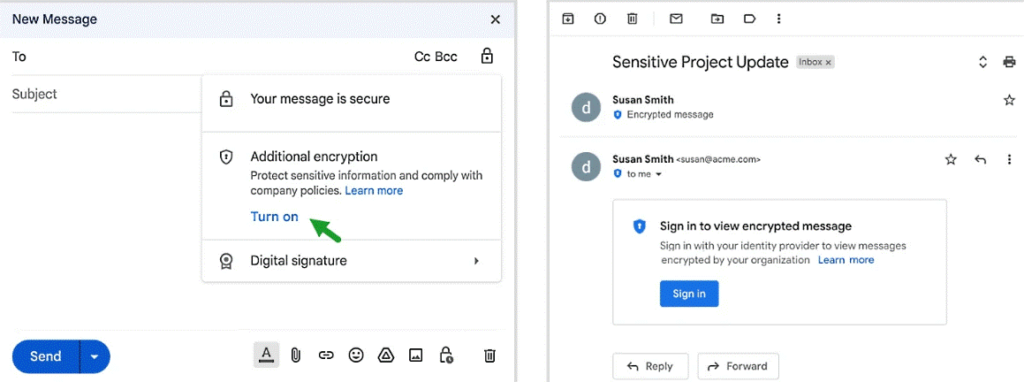Google has announced the implementation of end-to-end encryption (E2EE) for its popular email service, Gmail, on the web. The move comes in response to increasing concerns about online privacy and security and follows the company’s rollout of E2EE for its mobile apps earlier this year.
The functionality is presently in beta and may be activated by going to client-side encryption in the security settings admin console’s access and data management section. Customers with Google Workspace Education Plus, Enterprise Plus, & Education Standard are currently able to use it and can enroll for the beta program through January 20th, 2023. However, users with lower Workspace levels, personal Gmail accounts, and customers with earlier Business plans and G Suite Basic are not available.

For those who don’t know about E2EE let us take a look at a brief overview of the same.
What is End-To-End encryption and how does it work?
End-to-end encryption (E2EE) is a method of securely transmitting data from one device to another in such a way that only the intended recipient can access and read it. It involves encrypting the data at the sender’s device using a unique key, sending the encrypted data over a network (such as the internet), and decrypting the data at the recipient’s device using a matching key.
E2EE is used to secure communications between devices, such as when sending emails, and messages, or making phone calls. It ensures that the data cannot be accessed or read by anyone other than the intended recipient, even if the data is intercepted or transmitted over an unsecured network. This helps to protect the privacy and confidentiality of the communication.
E2EE uses cryptographic keys to encrypt and decrypt the data. These keys are normally generated and controlled by communication-related devices, and nobody else has access to them. This guarantees that the information stays safe and is inaccessible to unauthorized persons.
Read Also: Firefox Introduces Send, An End-To-End Encrypted File Transfer Service
In simple terms, “End-to-end encryption can be used to guarantee that the recipient of a message or piece of information is the only one who can read it. Take the situation when you wish to send your pal a secret message. You put the message in a special box and lock it with a key because you don’t want anyone else to be able to read it. Then you give your pal the key so they may use it to read the message and open the box.
Similar to traditional encryption, end-to-end encryption locks and unlocks messages using computer algorithms rather than a physical box and key. Nobody else can read the message; only the owner of the key, also known as a “decryption key.” This helps to preserve your privacy and prevent others from reading your messages, which is crucial when communicating sensitive information over the internet.”
How end-to-end encryption for Gmail web is going to help you?
With E2EE, all emails sent and received through the Gmail web interface will be encrypted from the sender’s device to the recipient’s device, using unique keys that are generated and managed by the device themselves. This means that the emails cannot be accessed or read by anyone other than the intended recipient, even if they are intercepted or transmitted over an unsecured network.
You can find all the details about this new E2E encryption feature for Gmail web on the Google Workspace blog.
The downside of using E2EE for Google Web –
Sure it is a good addition to Gmail but there is a little catch to using it. Some of the features like Smart Compose, adding a signature, or using emojis will not work
What will be encrypted with this new E2E encryption for Gmail?
Encrypted – Email body and attachments, including any inline graphics.
Not Encrypted – The subject of the mail, header, recipients lists, and timestamps.
Look at the table below on which of your favorite messaging/communication apps provides E2EE or not.
| E2EE Encryption | Apps |
| Provide by default | WhatsApp, FaceTime, iMessage, Line, Google Duo, and Viber |
| Provide but not set as default | Telegram, Facebook Messenger, Google Allo, and Kakao Talk |
| Does not provide | Skype, Snapchat, WeChat, Google Hangouts, Blackberry Messenger |
Winding it Up
So, this is how you can test the newly introduced end-to-end encryption for Gmail on your PC/Laptop. The rollout of E2EE for the Gmail web interface will be gradual, with the feature becoming available to all users over the coming weeks.
Have you got any queries or suggestions about this topic? Please feel free to discuss them in the section below. And for more of such latest tech news, troubleshooting guides, and tips & tricks related to Windows, Android, iOS, and macOS, follow us on Facebook, Instagram, and YouTube
Next Read: Most Secure Web Browsers For Android


 Subscribe Now & Never Miss The Latest Tech Updates!
Subscribe Now & Never Miss The Latest Tech Updates!